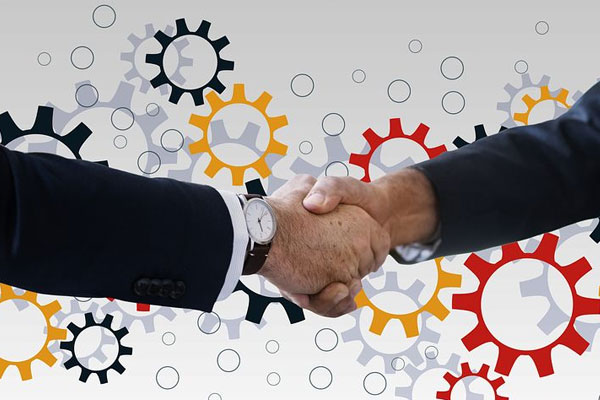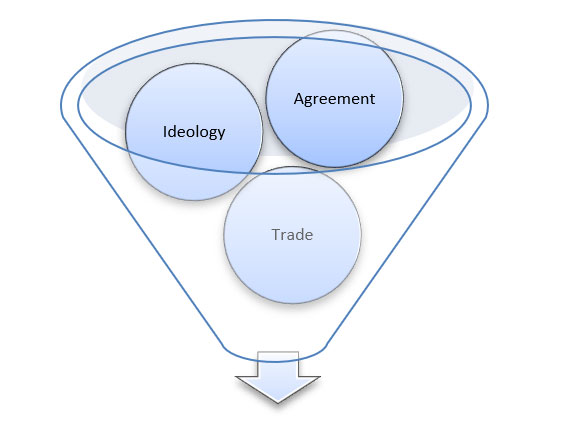Trade Union in HRM, Objectives, Types, Functions, and Role: A Trade Union is an amalgamation of workers, labor as well as employees to accomplish their demands for getting better working conditions at the premises of a business firm. They are also known as Labor Union in the United States. It is an organization of employees to fulfill all the needs of different levels of employees to achieve objectives in their fields such as wages or salary and working conditions in a business firm.

Also See: Evolution and History of Human Resource Management
This union is established to tackle various problems of laborers and the nature of problems varies such as unfair rules for working, unlimited working hours, and various concerns about the pay. Workers Union is the representation of all the employees who are working under an employer. Through the union, all the communications between the employee’s demand and the employer take place. These unions maintain discipline and also establish better relations between the management and workers and on the other side, trade unions take disciplinary actions against the misbehaving workers and also, maintain peace and harmony at the job place.
Also See: 9 Types of Human Resources Never Discussed Before
Trade Union in HRM, Objectives, Types, Functions, and Role
In this article, we are going to discuss various objectives, types, functions, and roles of trade union in HRM.
Objectives of Trade Union in HRM
Trade Union is set up to fulfill and achieve some of the objectives related to the workforce and the management of an organization. Here, we have jotted down some of the objectives that main engender behind this establishment. Let us have a look.
1. Wages and salaries:
The major point of concentration of the trade union is wages and salaries. After all, these matters are related to the policies of employment ad thus, it becomes the stress point from the Trade Union’s point of view. But there are different arises while implementing such policies as it varies from employer to employer. Trade Union plays an important role in bargaining the pay scales where there is less organized structure.
Also See: Harvard Model of HRM: Complete Detail with Diagram
2. Working conditions:
With an aim to safeguard the health of workers, they demand the management to provide all the necessary facilities such as lighting and ventilation, sanitation, rooms for rest, safety equipment while handling something disastrous, refreshment and drinking water, minimum hours for working, leave and rest, job satisfaction, benefits of social security and other related welfare measures.
Also See: Recruitment and Selection Process: Complete Guide
3. Discipline
The only aim of the trade union is not to conduct negotiations in terms of items and working conditions but also to protect the interest of the workforce from the clutches of management and prevent them from becoming the victim of the management’s unnecessary actions and other policies.
The victimization is in various forms such as penal transfers, suspensions, dismissals and so on. In all such circumstances, the workers who are left out can take assistance from the Trade Union. Further, the relevant actions will be taken by Trade union to bring illegal actions and explain about the injustice to an individual employee and fights on behalf of the individual. In this way, the victimized worker gets protection from the Trade Union.
4. Personnel Policies:
There are various implementations of the policies related to the workers and it is implemented by the management in a very wrong way that is not acceptable by the workforce. These actions can be taken in various aspects of HRM such as recruitment, selection, promotions, training, transfers and so on.
Also See: Importance of Motivation in HRM?
5. Welfare
As mentioned earlier, these unions are meant for the proper welfare of the workers. Trade union works as a guide, gives consultation to the authority and cooperates to overcome various problems related to the personnel policies. Through the collective bargaining meetings, the management brings into the notice of the management about the difficulties tackled by the workers associated with sanitation, hospitals, quarters, schools and educational institutes for the cultural and social problems of the children.
Also See: Fombrun Model of HRM
6. Employee-employer relation
To maintain peace in the industry, it is indispensable to maintain a harmonious relationship between the employee and employer which is a Sine Quo Non. Trade Union always makes an effort to accomplish the goals of an organization by establishing a better relationship between these two. But the attitude, as well as unilateral thinking of the authority, results in arguments and conflicts between the management and the workers. Being the representative of the workers, Trade Union always carries out steps and actions to negotiate with the management and promote industrial peace.
Also See: Top 15 Challenges of Human Resource Management
Functions of Trade Union in HRM
Innumerous functions are performed by the Trade Union in order to accomplish the objectives as it is indispensable. These functions are segregated into three categories which are given as follows:
1. Militant Functions
All the activities as performed by Trade Union lead to the betterment and improvement in the status of the members in relation to employment. These functions are entirely attached with the assurance of adequate wages or salaries, better conditions for work and employment and take better medical treatments and so on. When the union is not able to sort out the issues with the help of bargaining and negotiation, then they shift to another approach and put a fight against the management in the form of tricks, strike, boycott, lockouts, gherao and so on. These functions are known as fighting functions.
These functions aim at achieving the high wages as well as salary, better working conditions, improve the worker’s status and protect the interest of the worker being victimized.
Also See: Approaches to HRM
2. Fraternal Functions
The next function is performed for providing help to the workers when it is required to make improvements in their efficiency. It also encourages the labour spirit and motivates friendly relations between the industry and scatter education as well as a culture among the employees. They also take some measures to build up confidence among employees and it leads to improving the morale of the employees. If it is needed, then legal help is also offered to the members and also undertake the publications and magazines of trade unions.
Moreover, they also take up the work of welfare such as education for children, library, reading rooms, indoor and outdoor games and other associated amusement facilities. All these activities called as fraternal Activities. The functions of trade union include improvement in worker’s morale, generate confidence, foster discipline and sincerity, provide growth and promotion opportunities and protect gender discrimination against women workers.
Also See: Human Resource Management Process with in Depth Detail
3. Social Functions:
Apart from the economical functions of the Trade Union such as organizing unions and improving terms and conditions, the union started providing a wide array of welfare services to the workers as well as to the community. These functions are sub-categorized under three heads below.
- Welfare activities: It improves the quality of work-life which includes mutual fund, cooperative societies for housing, cooperative stores, cultural programs, banking and medical facilities and also provide proper training to women in various crafts.
- Education: Educate the workers related to all the aspects which comprise of improving the civic life, environment awareness, enhance their knowledge related to working and also teach them their responsibilities and participation of worker in the management.
- Redressing their grievances: Few Trade Union also assisting the governmental authorities to implement various working education scheme.
4. Political functions:
This function is associated with getting the affiliation from the political party an assisting them in enrolling more and more members, in return the political parties helping the trade union during the time of strikes and lockouts.
Also See: Scope of Human Resource Management: Complete Reference
Types and Classification of Trade Union in HRM
Several types of a trade union are there that serves different sort of workers. Here, we have jotted down the trade unions into three categories as given below.

1. Classification on the basis of Ideology
According to the ideology, a labour union is segregated into three parts which are named as revolutionary unions, reformist or welfare unions and uplift unions which are as discussed below.
- Revolutionary Unions: This type of union is related to believe in the transformation of the social as well as economic order and create some new one. Moreover, it may lead to change the authority and power.
- Reformist or Welfare Unions: It is associated with the change and reforms in the field of working conditions within the current framework of the socio-economic and socio-political European model.
- Uplift Unions: Beyond the area of working conditions, it is attached with the extensive reforms such as making changes in the taxation system, eliminate the poverty and so on.
Also See: Ethics in HRM (Human Resource Management)
2. Classification on the basis of trade
Few unions have some memberships as well as jurisdictions on the basis of their trades that they indicate. Craft Union is the narrow membership and includes the workers who are certified in certain trade or craft such as pipe fitting, clerical work, carpentry and so on. But these unions are less common in India and Sri Lanka and common in another western world.
At the next extreme, there is a general union that represents workers from all sort of industries and companies. There are two general worker categories under trade union which is known as blue-collar workers such as workers on the production floor, construction work, etc. and white-collar workers like management staff and clerical staff.
Also See: 20 Objectives of Human Resource Management
3. Classification on the basis of an agreement
Another type of trade union is classified on the basis of agreement and based on the level to which the condition of employment is the membership. Some heads are given below that considered under this kind of trade union.
- Closed Shop: The closed shop refers to the agreement between the management and the union that recruitment of the workers is done by the trade union. An employee becomes part of the shop when they enjoy the trade union.
- Union Shop: It includes a fixed period of time under which a worker must join the trade union after employment and it is a kind of agreement which is known as a union shop.
- Preferential Shop: It is related to giving the preference to a member. This agreement is associated with giving more preference to the worker while filling up the vacancies which are called as Preferential Shop.
- Maintenance Shop: In this type of shop, there is no such compulsory membership in the union, not before and after the recruitment. But, if the worker wants to become a member of a trade union, then it is mandatory in such cases to remain the member during the employment tenure of the employee. This is also known as a membership shop.
- Agency Shop: It is a kind of payment union. However, it is a sort of agreement between the management and the union, if a non-union member wants to become a member of the trade union, then they have to pay a definite sum of money to the union trade as a member’s subscription in order to continue employment with the employer.
- Open Shop: In such an agreement between the union and the management, it is not compulsory or mandatory to become a member of trade union either before or after recruitment.
Also See: 21 Vital Importance of HRM(Human Resource Management)
Conclusion
Overall, the Trade Union in HRM is related to the survival strategy to deal with all sorts of economic, social and working cultures in an organization. It ensures that not even a single aspiration and interest of workers have been neglected.
So it was all about Trade Union in HRM, Objectives, Types, Functions and Role, if you have query them you can ask us in the comment section.


